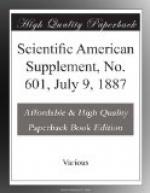best for withstanding the London climate, and for
making full use of the capabilities of brickwork that
can be employed, and I have no doubt that in the future
it will be frequently resorted to. Some of those
examples also show the introduction of cast ornaments,
and others the employment of carving as means of enriching
the surface of brick walls with excellent effect.
Here we must leave the subject; but in closing, I
cannot forbear pointing to the art of the bricklayer
as a fine example of what may be accomplished by steady
perseverance. Every brick in the miles of viaducts
or tunnels, houses, or public buildings, to which we
have made allusion, was laid separately, and it is
only steady perseverance, brick after brick, on the
part of the bricklayer, which could have raised these
great masses of work. Let me add that no one
brick out of the many laid is of no importance.
Some time ago a great fire occurred in a public asylum,
and about L2,000 of damage was done, and the lives
of many of the inmates endangered. When the origin
of this fire came to be traced out, it was found that
it was due to one brick being left out in a flue.
A penny would be a high estimate of the cost of that
brick and of the expense of laying it, yet through
the neglect of that pennyworth, L2,000 damage was
done, and risk of human life was run. I think
there is a moral in this story which each of us can
make out if he will.
* * * *
*
A fireproof whitewash can be readily made by adding
one part silicate of soda (or potash) to every five
parts of whitewash. The addition of a solution
of alum to whitewash is recommended as a means to prevent
the rubbing off of the wash. A coating of a good
glue size made by dissolving half a pound of glue
in a gallon of water is employed when the wall is
to be papered.
* * * *
*
PHENOMENA OF ALTERNATING CURRENTS.
[Footnote: From a paper read before the recent
meeting of the American Institute of Electrical Engineers,
New York, and reported in the Electrical World.]
By Prof. ELIHU THOMSON.
The actions produced and producible by the agency
of alternating currents of considerable energy are
assuming greater importance in the electric arts.
I mean, of course, by the term alternating currents,
currents of electricity reversed at frequent intervals,
so that a positive flow is succeeded by a negative
flow, and that again by a positive flow, such reversals
occurring many times in a second, so that the curve
of current of electromotive force will, if plotted,
be a wave line, the amplitude of which is the arithmetical
sum of the positive and negative maxima of current
or electromotive force, as the case may be, while
a horizontal middle line joins the zero points of current
or electromotive force.
[Illustration: FIG. 1]




